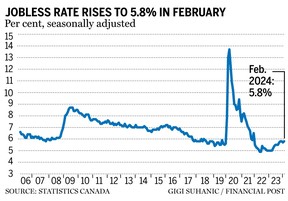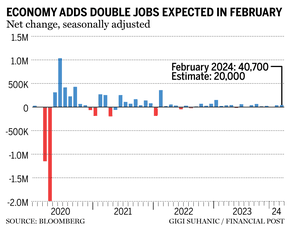Unlikely to move the bar on Bank of Canada rate cut, say economists

Article content
Canada’s economy gained 41,000 jobs in February, but the unemployment rate ticked up to 5.8 per cent, Statistics Canada reported Friday.
The job gains more than doubled expectations of economists surveyed by Bloomberg. Employment growth, however, continued to lag population growth, with the employment rate falling by 0.1 percentage points to 61.5 per cent.
Advertisement 2
Article content
Article content
The employment rate has now decreased for five months in a row, the longest losing run since 2009.
“This downward trend is associated with rapid population growth, which has outpaced employment growth in the past year,” Statistics Canada said.

The data show Canada’s economy grew in early 2024, but not fast enough to keep up with the rising population, Royal Bank of Canada’s assistant chief economist Nathan Janzen said in a note, adding that this is why the unemployment rate edged higher.
Average hourly wage growth eased to five per cent from 5.3 per cent in January, which could help cool core inflation later this year, Dominique Lapointe, director of macro strategy for Manulife Investment Management, said.
Job gains, which were driven by full-time employment, were spread across several industries in the services-producing sector.
“Today’s report is certainly impressive at first blush, particularly the towering rise in full-time jobs,” BMO chief economist Douglas Porter said in note. “However, it’s staggeringly clear that the results are flattered by ongoing massive population gains, and the labour market is thus actually gradually cooling.”
Article content
Advertisement 3
Article content
Job gains were driven by a rise in self-employed positions, up 38,300, the first monthly increase since August 2023. Despite self-employment accounting for most of the full-time job gains, the category remains weak, said Statistics Canada.
The Bank of Canada, which held its benchmark interest rate at five per cent this week, will be watching the data to gauge inflation risks, but economists said these numbers aren’t likely to move the bar.
“The Canadian labour market continues to loosen, albeit at a snail’s pace that isn’t going to speed up the timeline for Bank of Canada interest rate cuts,” CIBC Capital Markets economist Andrew Grantham said in a note on the data.

The 0.1 percentage point rise in the unemployment rate merely reversed a surprise decline in the rate the month before. This rate has held relatively steady, sitting at 5.8 per cent for three of the past four months.
And though wage growth eased, it remains higher than the central bank would likely want to see, Grantham said.
Recommended from Editorial
Advertisement 4
Article content
Much of the increase in unemployment has come from longer job searches for new labour market entrants, such as students, but the number of permanent layoffs is also up 32 per cent from a year ago in February, RBC’s Janzen said.
He said the unemployment rate is still expected to edge higher in the first half of this year as the economy slows further.
“We continue to expect the combination of a softening economic backdrop and slowing inflation pressures will allow the BoC to pivot to gradual interest rate cuts starting in June,” Janzen said.
• Email: dpaglinawan@postmedia.com
Bookmark our website and support our journalism: Don’t miss the business news you need to know — add financialpost.com to your bookmarks and sign up for our newsletters here.
Article content
https://news.google.com/rss/articles/CBMiS2h0dHBzOi8vZmluYW5jaWFscG9zdC5jb20vbmV3cy9lY29ub215L2NhbmFkYS1qb2ItZ2FpbnMtZG91YmxlLWV4cGVjdGF0aW9uc9IBAA?oc=5
2024-03-08 17:05:53Z
CBMiS2h0dHBzOi8vZmluYW5jaWFscG9zdC5jb20vbmV3cy9lY29ub215L2NhbmFkYS1qb2ItZ2FpbnMtZG91YmxlLWV4cGVjdGF0aW9uc9IBAA


Comments